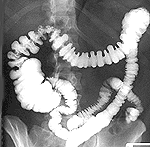Contrast X-rays
Sometimes contrast material is given to help outline body structures in the resulting X-rays.
Blood Vessel Contrast X-rays
A different type of contrast material is injected into the blood stream to image blood vessels. If the liquid contrast is injected into a vein, the procedure is called a venogram. If the liquid contrast is injected into an artery, the procedure is called an arteriogram. Because these procedures involve entry into the blood stream there is a little more discomfort involved. Usually the doctor gives a local anesthetic, or numbing medicine, to decrease pain at the injection site. Also, when the contrast material is injected, the patient may experience a warm or flushing sensation, which usually only lasts for a few seconds.
These imaging procedures are performed on many areas of the body. One of the most common arteriograms performed is called a coronary arteriogram or cardiac catheterization. In this case the blood vessels, coronary arteries that supply the heart muscle, are briefly filled with contrast material. A number of X-rays are taken and a kind of moving picture, called a cine, is created as the contrast material moves through the arteries. This examination helps determine if there are blockages in the coronary arteries that may require opening, a procedure called angioplasty or if coronary artery bypass surgery is necessary.
Arteriograms are also performed in the main blood vessel in the body called the aorta. This test is called the aortogram. Sometimes this artery can become abnormally enlarged, a condition called an aneurysm. This can occur in the chest or abdomen. The aortogram helps define just where the problem lies. Arteriograms can also be performed in the arms and legs to look for blockages to blood flow.
A pulmonary arteriogram studies the arteries that go to the lungs. This test is often performed when it is suspected that blood clots may have traveled from another site such as the legs and settled in the lungs.
Similarly, cerebral arteries that supply the brain can be studied to look for blockages or aneurysms. This procedure is called a cerebral arteriogram.
Gastrointestinal Tract Contrast X-rays
Barium is commonly given as a liquid to drink in the Radiology Department. Then many films are taken as the barium makes its way down the esophagus and into the stomach and upper small intestine. This is known as an "upper GI series." In this case, the barium distinctly outlines the esophagus, stomach and upper small intestine in a way not possible with a standard X-ray. Although the barium doesn't taste very good, most patients do not experience any discomfort with this procedure. Barium can also be given as an enema (rectally). This is a little more uncomfortable, but most patients tolerate the procedure well. This procedure is called a "lower GI series" and images the lower part of the bowel called the large intestine (colon).
 Contrast X-ray using barium enema to show
outline of the large intestine (colon)
Contrast X-ray using barium enema to show
outline of the large intestine (colon)